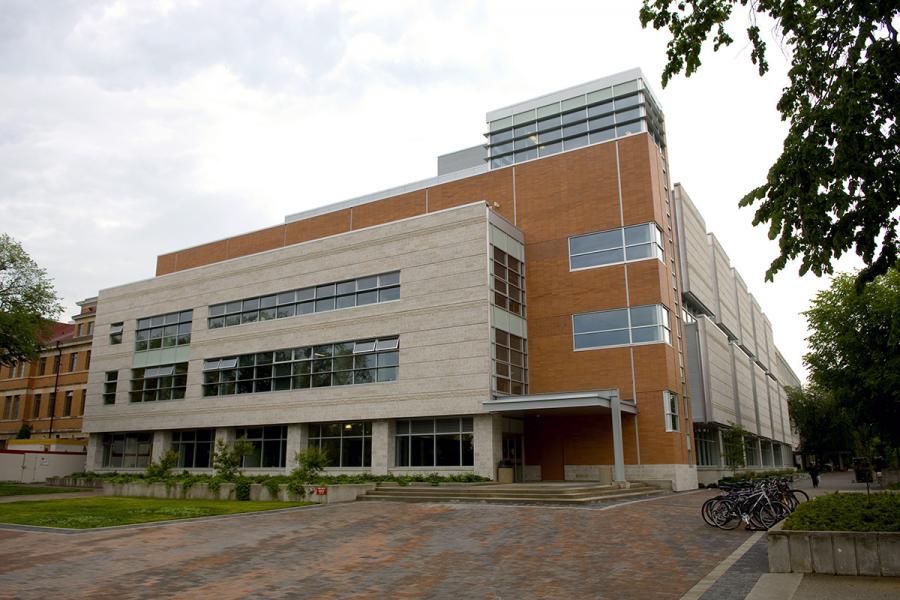Assistant Professor
Department of Biosystems Engineering
Room E1-310 EITC
97 Dafoe Road W
University of Manitoba (Fort Garry campus)
Winnipeg, MB R3T 5V6
Warren.Blunt@umanitoba.ca
204-474-7144
The University of Manitoba campuses and research spaces are located on original lands of Anishinaabeg, Ininiwak, Anisininewuk, Dakota Oyate, Dene and Inuit, and on the National Homeland of the Red River Métis. More
University of Manitoba
Winnipeg, Manitoba Canada, R3T 2N2

Assistant Professor
Department of Biosystems Engineering
Room E1-310 EITC
97 Dafoe Road W
University of Manitoba (Fort Garry campus)
Winnipeg, MB R3T 5V6
Warren.Blunt@umanitoba.ca
204-474-7144
In 2009, Dr. Blunt became involved in research in the Department of Biosystems Engineering as a summer research assistant investigating biofuels from lignocellulosic sources. This experience would unknowingly become the launch of not only a keen interest in sustainability, but also a subsequent career trajectory. This interest saw him through two additional undergraduate summers, as well as provided the opportunity to work and collaborate internationally with Scion (a Sustainable Forestry Research Institute in Rotorua, New Zealand) after being awarded an NSERC Michael Smith Foreign Study Supplement. Dr. Blunt completed a Ph.D in from the Department of Biosystems Engineering in 2019, studying production of microbial-based bioplastics. He subsequently joined the National Research Council of Canada as an Assistant Research Officer with the Aquatic and Crop Resource Development Research Centre. During this time, Dr. Blunt developed and led client-driven and collaborative research projects while working alongside Canadian Small-Medium Enterprises, non-profit organizations, other government departments, and international governments with the goal of fostering a competitive Canadian Bio-economy.
In 2023, Dr. Blunt started a new role as Assistant Professor in the Department of Biosystems Engineering.
Microbial bioprocess development for biotransformation of agro-industrial waste materials to value-added bio-based specialty chemicals.
Microbial fermentation, process development, chemical engineering, mass transfer, waste valorization.
Dr. Blunt's research program focuses on developing efficient bioprocesses that utilize microbial metabolism to convert low-value agro-industrial wastes into value-added bio-based specialty chemicals. The crux of this research is application of advanced process monitoring tools to investigate the interface between microbial metabolism and process engineering controls, and how this affects key performance metrics.
Not currently seeking graduate students.
https://scholar.google.com/citations?user=Tgv2AfUAAAAJ&hl=en
https://www.researchgate.net/profile/Warren-Blunt
Blunt W, Blanchard C, Doyle C, Vasquez,V, Ye M, Adewale P, Liu Y, Morley K, Monteil-Rivera, F. 2023. The potential of Burkholderia thailandensis E264 for co-valorization of C5 and C6 sugars into multiple value-added bio-products. Bioresource Technology, 129595. 10.1016/j.biortech.2023.129595
Blunt W, Shah P, Vasquez V, Ye M, Doyle C, Liu Y, Saeidlou D, Monteil-Rivera F. 2023. Biosynthesis and properties of polyhydroxyalkanoates synthesized from mixed C5 and C6 sugars obtained from hardwood hydrolysis. New Biotechnology.
10.1016/j.nbt.2023.06.005
Blunt, W., Blanchard, C., & Morley, K. (2022). Effects of environmental parameters on microbial rhamnolipid biosynthesis and bioreactor strategies for enhanced productivity. Biochemical Engineering Journal, 182, 108436. DOI: 10.1016/j.bej.2022.108436
Dartiailh C, Blunt W, Sharma PK, Liu S, Cicek N, Levin DB. 2021. The thermal and mechanical properties of medium chain-length polyhydroxyalkanoates produced by Pseudomonas putida LS46 on various substrates. Frontiers in Bioengineering and Biotechnology 8. doi: 10.3389/fbioe.2020.617489
Blunt W, Lagassé A, Jin Z, Dartiailh C, Sparling R, Gapes DJ, Levin DB, Cicek N. 2019. Efficacy of medium chain-length polyhydroxyalkanoate biosynthesis from different biochemical pathways under oxygen-limited conditions using Pseudomonas putida LS46. Process Biochemistry, 82, 19-31. DOI: 10.1016/j.procbio.2019.04.013
Blunt W, Gaugler M, Collet C, Sparling R, Gapes DJ, Levin DB, Cicek N. 2019. Rheological behaviour of high cell density Pseudomonas putida LS46 cultures during production of medium chain length polyhydroxyalkanoate (PHA) polymers. Bioengineering 6(4), 93. DOI:10.3390/bioengineering6040093
Blunt W, Dartiailh C, Sparling R, Gapes DJ, Levin DB, Cicek N. 2019. Development of high cell density cultivation strategies for improved medium chain length polyhydroxyalkanoate productivity using Pseudomonas putida LS46. Bioengineering 6(4), 89. DOI:10.3390/bioengineering6040089
Blunt W, Dartiailh C, Sparling R, Gapes D, Levin DB, Cicek N. 2018. Carbon flux to growth or polyhydroxyalkanoate synthesis under microaerophilic conditions is affected by fatty acid chain-length in Pseudomonas putida LS46. Applied Microbiology and Biotechnology, 102, 6437-6449. DOI: 10.1007/s00253-018-9055-9
Blunt W, Levin DB, Cicek N. 2018. Bioreactor operating strategies for improved polyhydroxyalkanoate (PHA) productivity. Polymers 10, 1197; DOI:10.3390/polym10111197
Blunt, W., Sparling, R., Gapes, D. J., Levin, D. B., & Cicek, N. (2018). The role of dissolved oxygen content as a modulator of microbial polyhydroxyalkanoate synthesis. World Journal of Microbiology and Biotechnology, 34, 1-13. DOI:10.1007/s11274-018-2488-6
Blunt W, Dartiailh C, Sparling R, Gapes DJ, Levin DB, Cicek, N. 2017. Microaerophilic environments improve the productivity of medium chain length polyhydroxyalkanoate biosynthesis from fatty acids in Pseudomonas putida LS46. Process Biochemistry, 59, 18-25. DOI: 10.1016/j.procbio.2017.04.028
Sharma PK, Munir RI, Blunt W, Dartiailh C, Cheng J, Charles, TC, Levin DB. 2017. Synthesis and physical properties of polyhydroxyalkanoate polymers with different monomer compositions by recombinant Pseudomonas putida LS46 expressing a novel PHA synthase (PhaC116) enzyme. Applied sciences, 7(3), 242. DOI: 10.3390/app7030242
Munir RI, Spicer V, Krokhin OV, Shamshurin D, Zhang X, Taillefer M, Blunt, W, Cicek N, Sparling R, Levin DB. 2016. Transcriptomic and proteomic analyses of core metabolism in Clostridium termitidis CT1112 during growth on α-cellulose, xylan, cellobiose and xylose. BMC microbiology, 16(1), 1-21. 10.1186/s12866-016-0711-x
Blunt W, Taillefer M, Gapes DJ, Sparling R, Levin DB, Cicek N. 2015. Evaluating supersaturation of in situ produced gases during thermophilic cellobiose fermentation with Clostridium thermocellum. Transactions of the ASABE, 58(5), 1149-1157. DOI: 10.13031/trans.58.11297